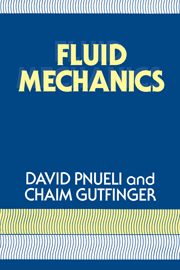Book contents
- Frontmatter
- Contents
- PREFACE
- 1 INTRODUCTION
- 2 STRESS IN A FLUID
- 3 FLUID STATICS
- 4 FLUIDS IN MOTION – INTEGRAL ANALYSIS
- 5 FLUIDS IN MOTION – DIFFERENTIAL ANALYSIS
- 6 EXACT SOLUTIONS OF THE NAVIER–STOKES EQUATIONS
- 7 ENERGY EQUATIONS
- 8 SIMILITUDE AND ORDER OF MAGNITUDE
- 9 FLOWS WITH NEGLIGIBLE ACCELERATION
- 10 HIGH REYNOLDS NUMBER FLOWS – REGIONS FAR FROM SOLID BOUNDARIES
- 11 HIGH REYNOLDS NUMBER FLOWS – THE BOUNDARY LAYER
- 12 TURBULENT FLOW
- 13 COMPRESSIBLE FLOW
- 14 NON-NEWTONIAN FLUIDS
- APPENDIXES
- INDEX
4 - FLUIDS IN MOTION – INTEGRAL ANALYSIS
Published online by Cambridge University Press: 05 June 2012
- Frontmatter
- Contents
- PREFACE
- 1 INTRODUCTION
- 2 STRESS IN A FLUID
- 3 FLUID STATICS
- 4 FLUIDS IN MOTION – INTEGRAL ANALYSIS
- 5 FLUIDS IN MOTION – DIFFERENTIAL ANALYSIS
- 6 EXACT SOLUTIONS OF THE NAVIER–STOKES EQUATIONS
- 7 ENERGY EQUATIONS
- 8 SIMILITUDE AND ORDER OF MAGNITUDE
- 9 FLOWS WITH NEGLIGIBLE ACCELERATION
- 10 HIGH REYNOLDS NUMBER FLOWS – REGIONS FAR FROM SOLID BOUNDARIES
- 11 HIGH REYNOLDS NUMBER FLOWS – THE BOUNDARY LAYER
- 12 TURBULENT FLOW
- 13 COMPRESSIBLE FLOW
- 14 NON-NEWTONIAN FLUIDS
- APPENDIXES
- INDEX
Summary
Moving fluids are subject to the same laws of physics as are moving rigid bodies or fluids at rest. The problem of identification of a fluid particle in a moving fluid is, however, much more difficult than the identification of a solid body or of a fluid particle in a static fluid. When the fluid properties, e.g., its velocity, also vary from point to point in the field, the analysis of these properties may become quite elaborate.
There are cases where such an identification of a particle is made, and then this particle is followed and the change of its properties is investigated. This is known as the Lagrangian approach. In most cases one tries to avoid the need for such an identification and presents the phenomena in some field equations, i.e., equations that describe what takes place at each point at all times. This differential analysis, which is called the Eulerian approach, is the subject of the next chapter.
There exist, however, quite a few cases where there are sufficient restrictions on the flow field, such that while the individual fluid particles still elude identification, whole chunks of fluid can be identified. When this is the case, some useful engineering results may be obtained by integrating the relevant properties over the appropriate chunk. This approach is known as integral analysis.
In most cases where integral representation is possible, there are walls impermeable to the fluid.
- Type
- Chapter
- Information
- Fluid Mechanics , pp. 97 - 140Publisher: Cambridge University PressPrint publication year: 1992



